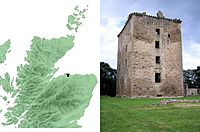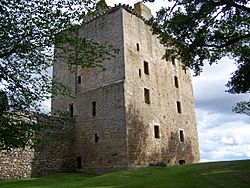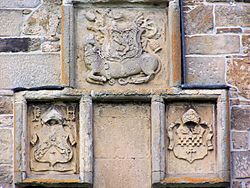Spynie Palace facts for kids
Quick facts for kids Spynie Palace |
|
|---|---|
| Spynie, Nr Elgin, Moray, Scotland | |
 |
|
| Coordinates | 57°40′34″N 03°17′29″W / 57.67611°N 3.29139°W |
| Type | Keep with curtain wall |
| Height | 22 metres |
| Site information | |
| Owner | Historic Environment Scotland |
| Open to the public |
Yes |
| Condition | Ruin |
| Site history | |
| Built | 1st c1150 2nd c1250 |
| Built by | Bishop of Moray |
| In use | c1150 – 1689 |
| Materials | Sandstone |
| Events | besieged 1640 and 1645 |
Spynie Palace, also called Spynie Castle, was a strong home for the Bishops of Moray for about 500 years. It's located in Moray, Scotland. This palace started being built in the late 1100s. It was very close to the first main church of the Moray area, which is now Spynie Churchyard. For most of its history, people called it a castle. The word palace was first used for it in 1524.
Contents
Spynie Palace: A Bishop's Home
The story of the Bishops of Moray is a bit unclear at the very beginning. The first bishop mentioned was Gregoir in the 1120s. Early bishops didn't have one main home. They moved between houses in Birnie, Kinneddar, and Spynie.
In 1172, King William I, the Lion, gave land to the church in Moray and to Bishop Simon de Toeni. Official permission to move the main church to Spynie was given by Pope Innocent III to Bishop Bricius de Douglas in 1206. The move likely happened by 1208.
Bishop Bricius later asked the Pope to move the church again, this time to Elgin. He felt the church at Spynie was too easy to attack and too far from the market. Elgin had a Royal castle, which seemed like a better choice. Bishop Bricius died in 1222 before the move happened. But his replacement, Bishop Andrew of Moray, completed the transfer. The main church moved to Elgin in 1224. However, the Bishop of Moray's home, Spynie Palace, stayed right where it was.
Building the Fortified Home
Early Days: 12th and 13th Centuries
The very first castle at Spynie was made of wood. It was built in the late 1100s. We know this from digging up the site between 1986 and 1994. The digs showed that the wooden buildings were surrounded by a rectangular earth wall and a ditch. This area was about the same size as the stone wall built later in the 1300s.
The buildings probably included the bishop's house with a main hall, a bedroom, and a chapel. There would also have been places for making beer and baking bread. Stone buildings started to appear in the 1200s. One of these was likely a chapel with colorful glass windows.
The first time the castle is mentioned in writing is in a document from the early 1300s. This document was probably used by English officials when King Edward I of England controlled Scotland. The first official order signed at Spynie Castle was in 1343.
Growing Stronger: 14th and Early 15th Centuries
Over time, the wooden buildings were slowly replaced with stone ones. This continued into the 1300s when the first main castle building was put up. It was a nearly square building inside a 7-meter-high stone wall. The main entrance was on the south side. A tower in the southeast corner had narrow openings for archers to shoot from.
In 1390, Alexander Stewart, Earl of Buchan, also known as the Wolf of Badenoch, attacked and burned Elgin Cathedral. It seems he also took Spynie Castle. King Robert III, who was Buchan's brother, told him in August 1390 not to interfere with Spynie Castle.
After Bishop Alexander Bur died in 1397, the King took control of the castle. This was normal when a bishop's position was empty. The King even made the Wolf of Badenoch, who had changed his ways, the castle's warden. When a new bishop was chosen, the King ordered Buchan to give the castle back to Bishop William in 1398.
Grand Additions: Later 15th and 16th Centuries
It's believed that Bishop John de Winchester (1435–1460) moved the main gate to the east wall. This new gate had a strong metal gate called a portcullis. You can still see parts of the gatekeeper's room, which even had a small fireplace. Bishop John was also the king's Master of Works. This meant he was in charge of building and fixing royal buildings. He worked on castles like Inverness and Urquhart, and the palace at Linlithgow. The beautiful stonework of the gate might have been done by the same skilled builders who were fixing Elgin Cathedral after it was burned in 1390.
The most important new buildings were added in the late 1400s and into the 1500s. This is when David's Tower, also called Davey's Tower, was built. It's the biggest medieval tower in Scotland by size. It measures 19 meters by 13.5 meters and is 22 meters tall. Bishop David Stewart (1462–1476) started it, and Bishop William Tulloch (1477–1482) finished it.
The tower has six floors above ground and an attic at the very top. Below ground, there's a basement with a round dungeon. The dungeon is 5.3 meters wide and only has one narrow window. The ground floor held the main hall, which was 12.8 meters by 6.7 meters. It had large windows with stone seats built into them. A spiral staircase in one corner led to the upper floors. Each of these floors had a large main room with smaller rooms leading off it. The tower looks simple from the outside. Its outer walls were originally covered in plaster, and the inside walls were also plastered.
Bishop Stewart also changed the old hall in the west part of the castle into kitchens for the new tower. People say he built the tower because the Earl of Huntly was bothering him. Stewart had even removed Huntly from the church for not paying his taxes.
In the mid-1500s, a walled garden was created south of the castle. It was mainly used as an orchard. A document signed in the garden in 1556 shows it was a nice place to relax. The people living in the castle also got more food when a rabbit farm and a dovecote (for pigeons) were added in 1569.
Bishop Patrick Hepburn (1538–1573) was the last Roman Catholic bishop at Spynie. He added wide gun-loops to make the castle's defenses stronger and made some windows larger. He continued to live at Spynie for a while even after the Reformation, which changed Scotland's religion.
A man named Ruxby, who worked for Elizabeth I of England, was held prisoner at Spynie Castle for 18 months in 1566. He had tried to get Mary, Queen of Scots involved in a plot with English Roman Catholics. Bishop Hepburn got into trouble with the Privy Council (a group of royal advisors) for helping his relative Bothwell in 1567. Bothwell had run away from Spynie to Orkney and then to Denmark.
After Queen Mary gave up her throne, Regent Morton and the Privy Council ordered that Spynie Castle be available to the Crown if needed. This was part of a plan to bring peace to the country.
On July 29, 1587, King James VI gave the castle and its land to Alexander Lindsay, 1st Lord Spynie. He kept them until he gave them back to the Crown in 1605. In 1595, Spynie was one of the castles that got extra defenses. This was because people feared an attack from the Spanish.
Decline and Ruin: 17th Century
In 1606, King James gave the castle and its income back to the Bishop of Moray. Bishop John Guthrie, who supported the king, stopped being bishop in 1638. This happened when all bishops were removed by the general assembly. However, he and his family continued to live at Spynie.
Guthrie refused to support the Covenanters, a group who opposed the king's religious policies. He got the castle ready for a siege. In 1640, Covenanter Col. Sir Robert Monro and 800 men arrived. Guthrie gave up the castle right away on July 16. The castle's weapons were removed, but Guthrie, his wife, and servants were allowed to stay inside. Even though he was under house arrest, Guthrie had to pay for the 24 soldiers guarding the castle.
In September 1640, Guthrie was put in prison in Aberdeen. The castle was then given to the Earl of Moray by King Charles I. Elgin and the areas around it strongly opposed the Royalists (supporters of the king). After his victory against the Covenanters in 1645, James Graham, Marquis of Montrose turned his attention to Elgin.
The Laird of Innes, Grant of Ballindalloch, and some townspeople from Elgin prepared the castle for a siege. Montrose took Elgin and burned the homes of leading Covenanter supporters. He also burned the farm buildings belonging to Spynie. But he did not try to take the castle itself. Spynie had become a center for the Covenanters in the area. The Royalists knew this. The Marquis of Huntly laid siege to the castle in late 1645. But the castle's defenses held strong until it was rescued by John Middleton.
After bishops were brought back to the Scottish Church in 1662, the castle went back to the church. But it was starting to fall apart. Parliament gave Bishop Murdo MacKenzie £1000 for repairs. This kept the building going until 1689. The last person to live there, Bishop William Hay, was forced to leave. He refused to promise loyalty to King William and Queen Mary.
The palace then became property of the Crown. Its beautiful ironwork and wood carvings were taken away. Local people took stones from the walls to use for their own buildings until the early 1800s. Then, it became owned by James Dunbar-Brander of Pitgaveny. In 1974, it was rented to the Department of the Works. By that time, the tower had a noticeable bulge in its east wall. This was because Covenanters had tried to blow it up, weakening the structure.
Major work was done in the late 1970s to make the structure stable. A large concrete base was put in to stop the tower from falling. A curtain wall was rebuilt to hide this base. Finally, Historic Scotland opened the Palace to the public in 1994.
Images for kids






